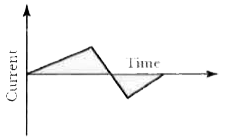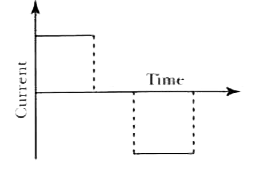A rigid wire loop of square shape having side of length L and resistance R is moving along the x-axis with a constant velocity v0 in the plane of the paper. At t=0, the right edge of the loop enters a region of length 3L where there is a uniform magnetic field B0 into the plane of the paper, as shown in the figure. For sufficiently large v0 the loop eventually crosses the region. Let x be the location of the right edge of the loop. Let v(x), I(x) and F(x) represent the velocity of the loop, current in the loop, and force on the loop, respectively, as a function of x. Counter-clockwise current is taken as positive.
 . Which of the following schematic plot(s) is (are) correct? (Ignore gravity)
. Which of the following schematic plot(s) is (are) correct? (Ignore gravity)




The correct Answer is:A, B
i=BLvR-(i)[counter clockwise direction
while entering, zero when conpletely
inside and clockwise while exiting]
F=iLB=B2L2vR -(ii) [Toward left while entering
and exiting and zero when completly inside]
∴−mVdvdt=B2L2vR
∴∫vv0(dv)=−B2L2mR∫x0dx
V=(V0)=−B2L2mRx
∴V=(V0)−B2L2vmR -(iii)
[V decreases from x=0 to x=L, remains constant for x=L to x=3L again decrease from x=3L→x=4L]<br>om(i)and(iii)
i=BLR[(V0)−B2L2vmR]
[i decreases from x=0 to x=L i become zero from x=L to x=3L i change direction and decreases from x=3L to x=4L]
These characteristics are shown in graph (a) and (b) only.
Topper's Solved these Questions
Similar Questions
A square loop of side d is moved with velocity vˆi in an non-uniform magnetic field B0axˆk then the emf induced shown is?

View SolutionA rectangular loop of dimensions l & w and resistance R moves with constant velocity V to the right as shown in the figure. It continues to move with same speed through a region containing a uniform magnetic field B directed into the plane of the paper & extending a distance 3W.
Sketch the flux, induced emf & external force acting on the loop as a function of the distance.

View Solution
Knowledge Check
A conducting loop carrying a current I is placed in a uniform magnetic field ponting into the plane of the paper as shown. The loop will have a tendency to
 AcontractBexpandCmove towards +vex−aξsDmove towards −vex−aξs
AcontractBexpandCmove towards +vex−aξsDmove towards −vex−aξsThere is a uniform magnetic field directed perpendicular and into the plane of the paper. An irregular shaped conducting loop is slowly changing into a circular loop in the plane of the paper. Then
Acurrent is induced in the loop in the anticlockwise directionBcurrent is induced in the loop in the clockwise directionCAltrenating current is induced in the loopDno current is induced in the loopA rectangular loop of wire in the plane of the paper starts outside a perpendicular uniform magnetic field directed into the paper as shown in the following figure. The loop is pulled with a constant velocity through the magnetic field and out the other side. Which of the following graphs would best represent the variation of the electric current in the wire with time?
 A
A B
B C
C D
D
A conducting rod AC of length 4l is rotated about point O in a uniform magnetic field →B directed into the plane of the paper. AO=landOC=3l. Find VA−VC.

View SolutionA square loop of a conducting material of side l and resistance r is dragged through a uniform magnetic field B with uniform velocity v keeping the plane of the loop perpendicular to the direction of the field. What is the current flowing through the loop?
View SolutionAn equilateral triangular loop ADC having some resistance is pulled with a constant velocity v out of a uniform magnetic field directed inot the paper. At time t=0, side DC of the loop at is at edge of the magnetic field.

The induced current (i) versus time (t) graph will be as
View SolutionA square-shaped conducting wire loop of dimension a moving parallel to the x-axis approaches a square region of size b (a<b) where a uniform magnetic field B exists pointing into the plane of the paper (see figure). As the loop passes through this region, the plot correctly depicting its speed (v) as a function of x is

View SolutionA square loop of side L, resistance R placed in a uniform magnetic field B acting normally to the plane of the loop. If we attempt to pull it out of the field with a constant velocity v, then the power needed is
View Solution
